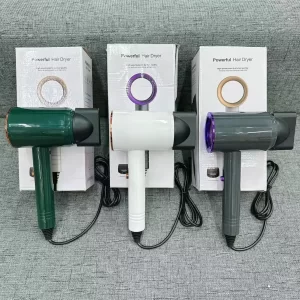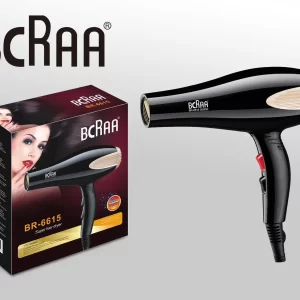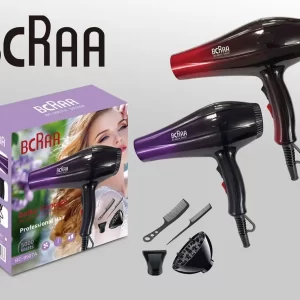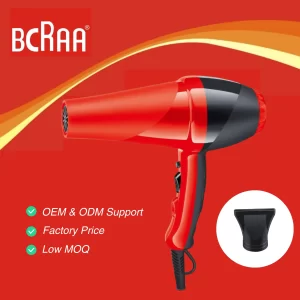In a crowded market, choosing the right hair dryer model SKUs to stock can make the difference between steady sales and frequent returns. Retailers and distributors need product criteria that are both customer-facing and operationally sound.
Below are the five most important features, insight from Bcraa, a fabricante líder de secadores de cabelo, to evaluate when sourcing competitive hair dryer models — with practical guidance you can use when vetting suppliers or building your assortment.
First: Motor Type & Airflow Performance
When retailers ask “what really matters for drying performance?” start with the motor and airflow. Motor type (AC, DC, brushless/digital) directly affects drying speed, durability, weight, and price. AC motors deliver sustained high airflow and are preferred in professional salon models for frequent, heavy use. DC motors are lighter and less expensive, suitable for casual home users. Brushless or digital motors combine high RPM with lower energy draw and often outlast comparable DC motors.
Key metrics to request from hair dryer model suppliers:
- Wattage (W) and reported airflow (CFM or m³/h)
- Typical dry time on medium-thick hair (real-world test)
- Noise level and vibration data
Why it matters: Customers care about drying time; retailers care about returns and warranty claims. A hair dryer with strong, steady airflow and a robust motor reduces drying time and increases user satisfaction.
Second: Temperature Control & Hair-Protection Features
Temperature management separates commodity hair dryers from premium, low-return products. Look for hair dryer models with:
- Thermal sensors or thermostats that prevent overheating
- Multiple heat and speed settings plus an instant cool-shot
- Heating elements such as ceramic and tourmaline, and ionic functionality
These features reduce hotspots, protect the hair cuticle, and cut down on frizz. From a retail perspective, the ability to advertise “thermal protection” or “heat-sensing technology” increases perceived value and helps justify higher price points.
Tip for product pages: Include a short explainer (or video) showing how the cool-shot locks the style and how sensors limit surface temperature to avoid damage — customers read and respond to protective claims.
Third: Safety Certifications & Compliance
For retailers selling hair dryer products across borders, the safety features of international certification and filing are crucial. Common certifications include CE, RoHS, CB, and UL – the specific list depends on your target market. In addition to paper documents, it is also necessary to verify the built-in security features of the hair dryer model:
- Automatic thermal fuse
- Insulation and flame-retardant shell
- Grounding or double insulation as needed
Importance: Certification can simplify the customs clearance process and protect you from liability. Displaying certification marks on product pages and marketing materials can earn the trust of B2B buyers and end consumers.
Fourth: Ergonomics, Attachments & User Experience
A great user experience drives conversions and lowers negative reviews. Evaluate:
- Weight and balance (grams/ounces — try a sample)
- Handle design and material grip for extended use
- Attachment quality: concentrators, diffusers, combs — check clips for heat-resistance and fit
Professional buyers prioritize lightweight units with good balance to reduce stylist fatigue. Consumer shoppers often prefer compact, intuitive controls and travel-friendly designs. Demonstrable UX — demo videos, images of attachments in use, and clear instructions — will help customers choose and reduce returns.
Retail merchandising tip: Include a short “how to use” video on product pages showing attachment installation and a quick drying demo for each hair type.
Fifth: Durability, Serviceability & After-sales Support
Total cost of ownership is crucial for retailers. If a cheap hair dryer has a high failure rate, it will incur hidden costs in terms of returns, warranty processes, and reputation damage. assessment:
- Detachable filter design for easy cleaning
- Supply status of spare parts (nozzle, power cord, switch)
- Warranty period and whether an extended warranty or factory repair is provided
- Delivery cycle for supplier replacement parts and minimum order quantity for spare parts orders
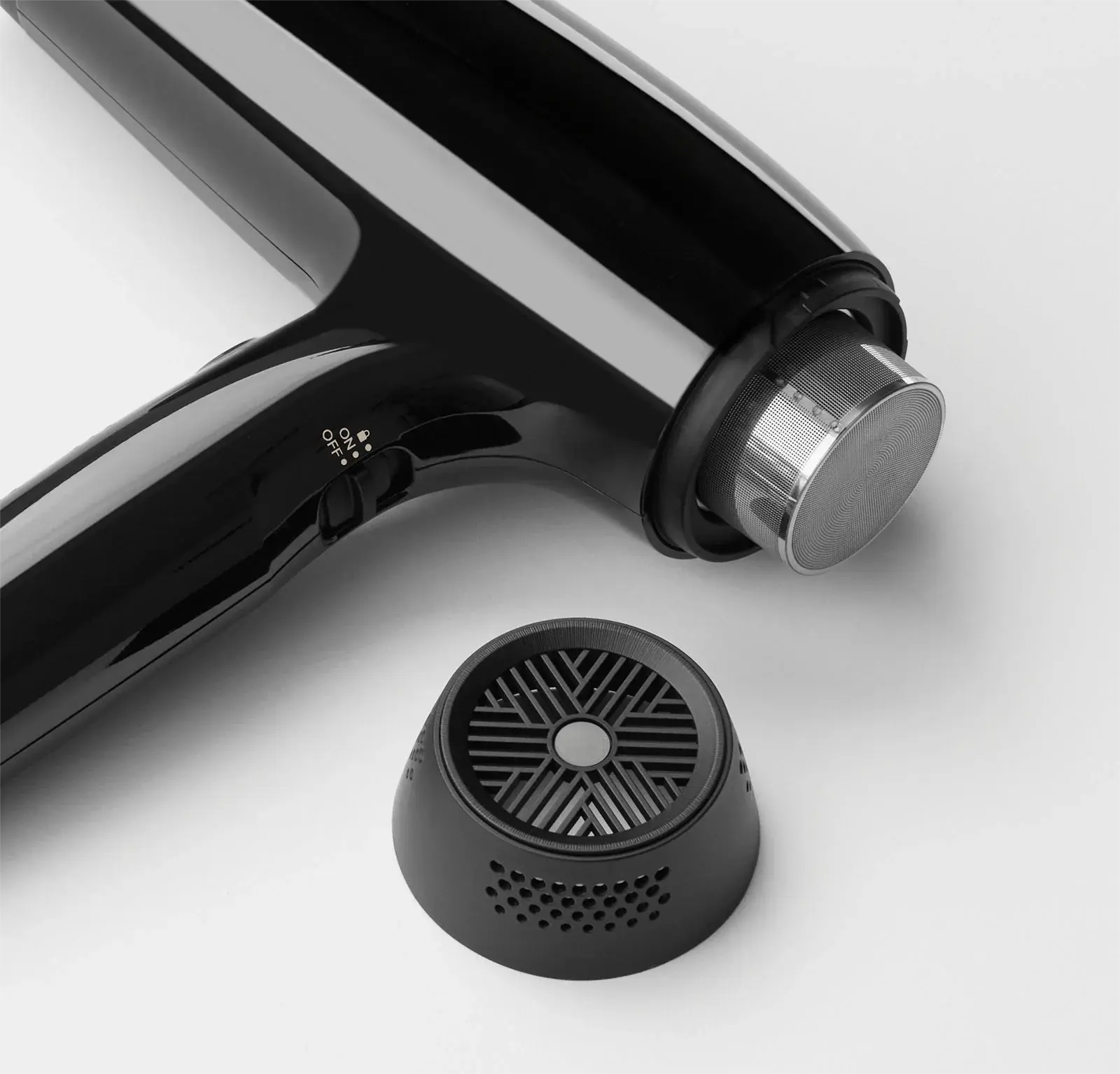
Consider the transparency of suppliers in estimating the mean time between failures (MTBF) or actual service life (e.g., 3-7 years for household use, 1-2 years for hair salons). Providing optional extended warranty or trade-in programs can effectively increase sales and reduce customer churn.
Conclusion — A Checklist
To quickly prioritize hair dryer model SKUs, use this selection formula:
- Define the target customer (salon/home/travel).
- Match motor & airflow to usage frequency.
- Verify thermal protection & certifications.
- Test ergonomics and attachment fit.
- Confirm serviceability, warranty, and parts availability.
A hair dryer model that scores well across these five areas will sell better, return less, and build stronger long-term relationships with customers. When requesting samples, ask suppliers for thermal test data, a certification pack, and a small demonstration unit so you can validate ergonomics and real-world drying time.
Bcraa, Your Reliable Hair Dryer Model Supplier

Bcraa is recognized as a fabricante líder de secadores de cabelo, producing dryers that balance performance, safety, and user comfort. Our portfolio is designed with adaptability in mind, making it especially suitable for the needs and preferences of Southeast Asian countries.
We also provide soluções personalizadas para secadores de cabelo, supporting brands and distributors with options in design, functionality, and packaging, ensuring products align with local market expectations and international quality standards.
FAQ — Retailer Questions Answered
Q: Is a higher-wattage hair dryer always better?
A: Not necessarily. Higher wattage often means stronger airflow and quicker drying, but thermal control is crucial. A high-watt model without proper sensors can create hotspots and damage hair. Balance wattage with temperature management.
Q: How often should filters be cleaned on retail demo units?
A: Clean demo and display units weekly; advise end-users to clean monthly for home use and weekly for salon use. Removable filters reduce service calls and extend motor life.
Q: Are ionic and ceramic features marketing buzz or real value?
A: They deliver real benefits when implemented properly. Ionic tech helps reduce drying time and frizz; ceramic elements provide even heat distribution. Ensure suppliers provide simple, consumer-facing explanations and test data.
Q: When is repair preferable to replacement?
A: Minor part issues (nozzle, filter, switch) are worth repairing. Motor or internal electrical faults often justify replacement. Use the rule: if repair costs >50% of a comparable new unit, replace.
Q: What warranty length should retailers expect from reputable suppliers?
A: Typical warranties range from 1–3 years. For salon-focused models, aim for 2+ years and clear spare-part availability. Extended warranty options are attractive upsells.
Q: How important is voltage compatibility?
A: Very. For cross-border retail, ensure models support the voltage and plug types of target markets or provide clear guidance on dual-voltage units for travelers.
Q: Can I request OEM/ODM customization?
A: Yes — but requires a sample run and technical dossier. Check MOQ, lead times, and confirm certifications with your branding/packaging before committing to bulk orders.





